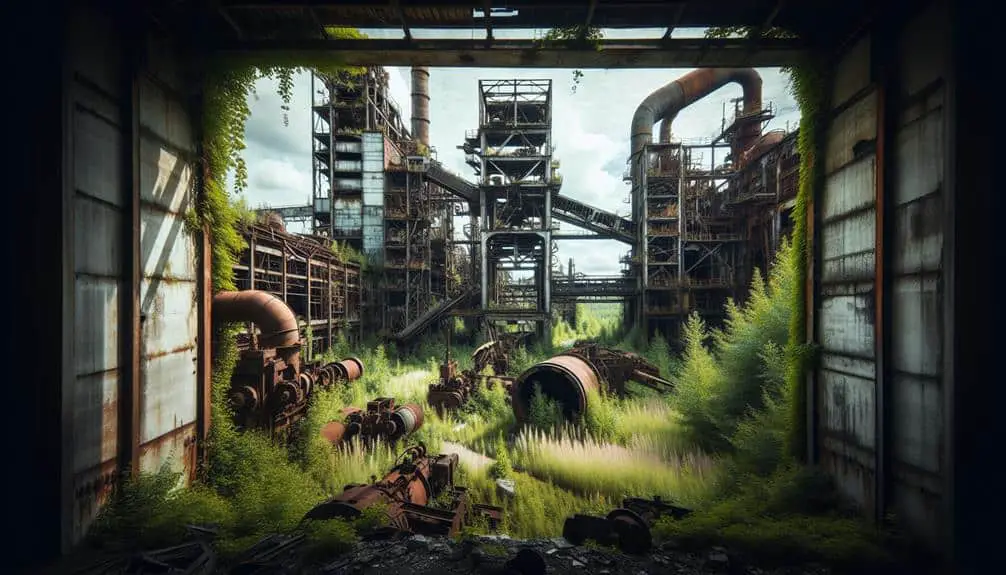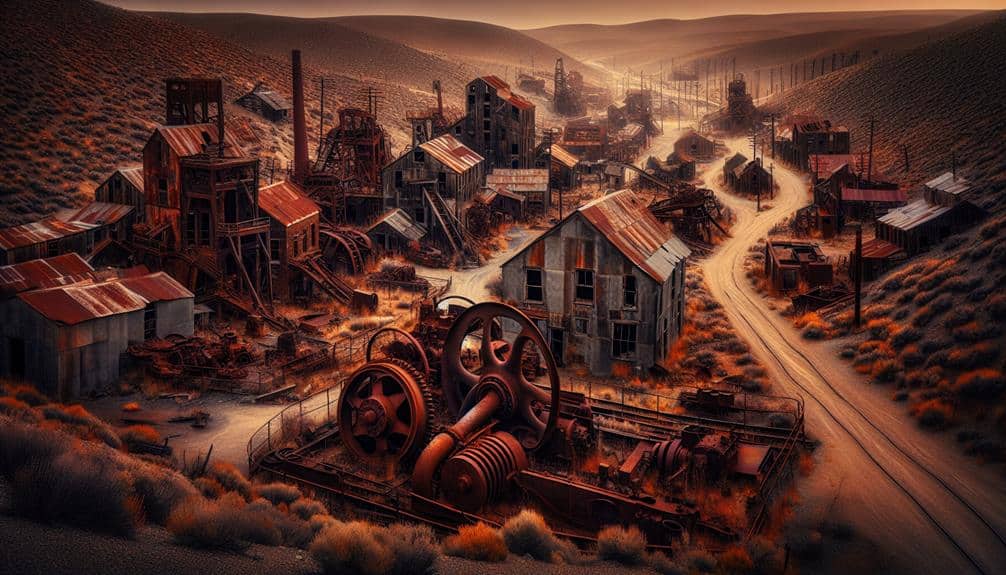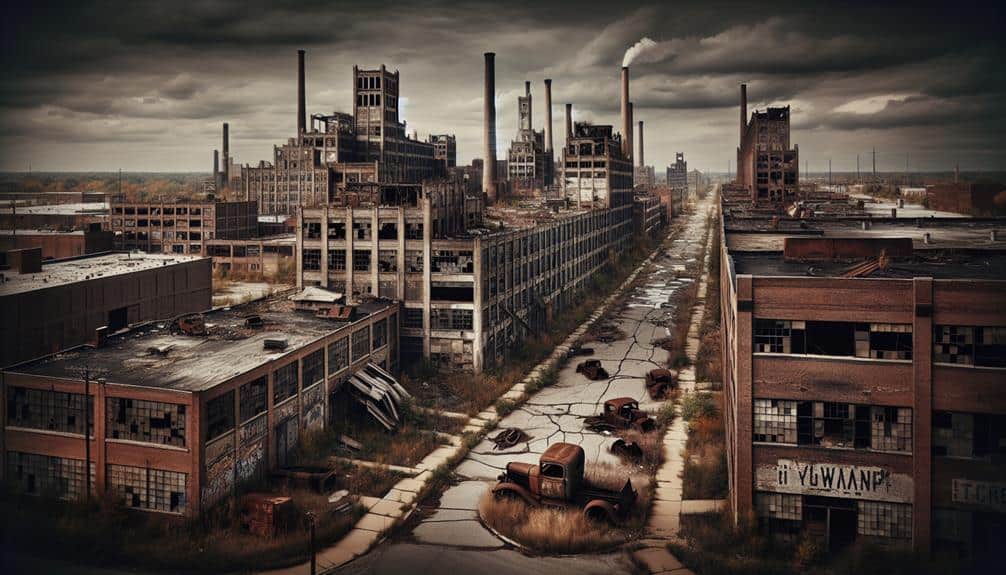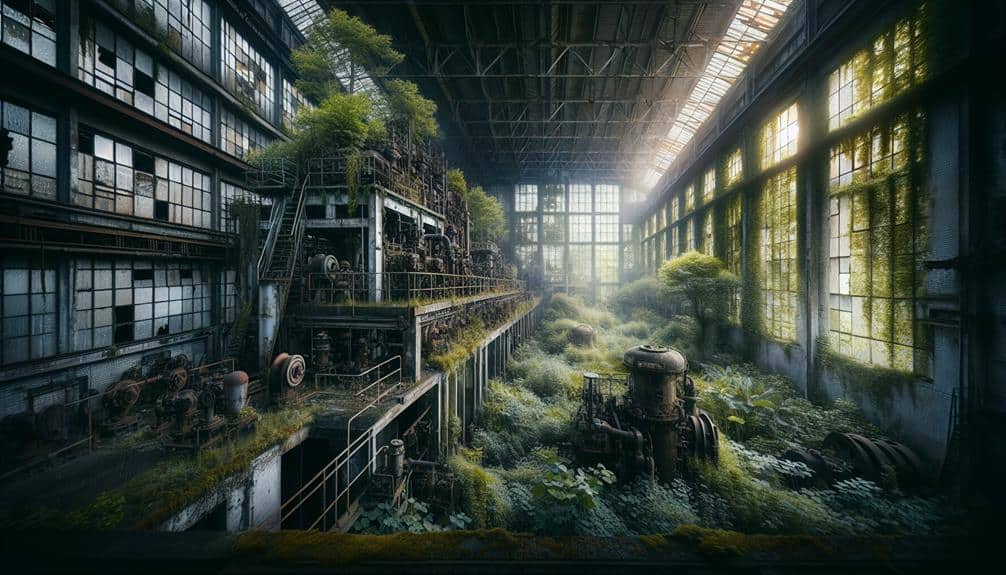In the silent industrial wastelands today, abandoned factories and hazardous waste materials linger as a somber reminder of economic decline and environmental degradation. Infrastructure like rail lines and roads lay desolate, a result of neglect over time. Factors like pollution and economic downturns have rendered these areas uninhabitable. Preservation efforts face challenges but are essential for historical integrity. Cultural tourism and economic revitalization offer glimpses of hope, drawing visitors and creating local business opportunities. The future holds promise with adaptive reuse, sustainable development, and a focus on environmental restoration. Discover more about the transformation and revitalization of these silent industrial wastelands.
Key Points
- Abandoned factories, hazardous waste, and degraded infrastructure persist.
- Environmental degradation and economic downturns contribute to their existence.
- Preservation efforts face challenges of funding and community involvement.
- Cultural tourism revitalizes these areas, creating jobs and local businesses.
- Future focus on adaptive reuse, sustainable development, and environmental restoration.
Origins of Industrial Ghost Towns
During the late 19th and early 20th centuries, industrial ghost towns emerged as a result of economic decline and technological advancements in manufacturing. The economic decline, often triggered by shifts in market demands or the obsolescence of existing production methods, led to the abandonment of once-thriving industrial centers. As industries struggled to remain competitive, many factories closed down, leaving behind desolate landscapes and empty buildings.
The environmental impact of these industrial ghost towns was profound. Abandoned factories and mills often left behind hazardous waste materials, contaminating soil and water sources. The lack of maintenance and oversight further exacerbated the environmental degradation, creating health risks for both wildlife and nearby communities. Additionally, the infrastructure built to support these industrial operations, such as rail lines and roads, fell into disrepair, further isolating these ghost towns from economic revitalization efforts.
Understanding the origins of industrial ghost towns provides valuable insights into the interconnectedness of economic forces and environmental consequences, highlighting the importance of sustainable industrial practices and proactive economic planning.
Factors Leading to Abandonment
What factors contribute to the abandonment of industrial ghost towns?
Industrial ghost towns are often left abandoned due to a combination of environmental degradation and economic downturns. Environmental degradation, such as pollution from industrial activities, can make an area uninhabitable and unattractive for both businesses and residents. This can lead to a decline in economic activity as businesses move out and jobs become scarce.
Furthermore, economic downturns play a significant role in the abandonment of industrial ghost towns. When industries experience a downturn, factories and businesses may shut down or move to more economically viable locations, leaving behind deserted towns with few opportunities for employment. This cycle of economic decline can further exacerbate environmental issues, creating a negative feedback loop that contributes to the abandonment of these areas.
Preservation Efforts and Challenges
Preservation efforts in industrial ghost towns face multifaceted challenges stemming from the complex interplay of historical significance, financial constraints, and community engagement. The historical significance of these sites often necessitates costly environmental restoration to guarantee their integrity. However, limited funding poses a major obstacle to achieving thorough restoration goals.
Community engagement is vital for the success of preservation initiatives, yet it can be challenging to rally widespread support due to varying interests and priorities within the community. Balancing the preservation of industrial heritage with the need for sustainable development further complicates the process.
Environmental restoration plays a pivotal role in preserving these sites for future generations, but it requires substantial financial investment and technical expertise. Collaborative efforts between government agencies, private investors, and local communities are essential to address these challenges effectively. By fostering a sense of shared responsibility and promoting awareness of the historical and environmental value of these industrial wastelands, successful preservation initiatives can be achieved.
Tourism and Economic Impact
Given the historical significance and preservation challenges faced by industrial ghost towns, exploring the tourism potential and economic impact of these sites becomes an essential aspect of their revitalization. Cultural tourism plays an important role in attracting visitors to these silent industrial wastelands, offering them a glimpse into the past and a unique experience. The economic revitalization of these areas through tourism can lead to job creation, local business growth, and infrastructure development.
Industrial ghost towns hold a certain allure for travelers seeking off-the-beaten-path destinations, contributing to the overall appeal of cultural tourism. By preserving the heritage and stories embedded in these silent industrial wastelands, communities can tap into a sustainable source of income while safeguarding their historical legacy. The economic impact of tourism in these areas extends beyond just financial gains, fostering a sense of pride and identity among locals. As these sites continue to attract visitors, they become hubs of cultural exchange and historical exploration, breathing new life into once-abandoned spaces.
Future of Silent Industrial Wastelands
Exploring the potential for adaptive reuse and sustainable development in silent industrial wastelands is essential for their future transformation and integration into modern landscapes. These areas present significant redevelopment opportunities, where old industrial sites can be repurposed for new uses that align with contemporary needs and environmental standards. By focusing on environmental restoration, these spaces can be revitalized while mitigating past ecological harm.
Redevelopment opportunities in silent industrial wastelands offer a chance to not only reclaim unused land but also to create sustainable urban spaces that contribute positively to communities. Through strategic planning and innovative design, these wastelands can be transformed into vibrant mixed-use developments, green spaces, or cultural hubs. This approach not only benefits the environment but also stimulates economic growth and social well-being.
Frequently Asked Questions
How Do Industrial Ghost Towns Impact the Mental Health of Nearby Residents and Workers?
When living near industrial ghost towns, your mental health may suffer due to isolation and environmental concerns. Community support and public awareness campaigns can mitigate these impacts, fostering a sense of unity and addressing critical health issues.
What Are the Environmental Consequences of Leaving Industrial Wastelands Abandoned?
Leaving industrial wastelands abandoned can result in severe environmental consequences. Soil contamination poses health risks, while economic downturns lead to community displacement. These issues must be addressed promptly to prevent further harm to both people and the environment.
Are There Any Documented Cases of Paranormal Activity in Silent Industrial Wastelands?
You may find some documented cases of paranormal activity in silent industrial wastelands. Haunted history reports and supernatural sightings have been noted in certain locations, adding an eerie dimension to these abandoned sites.
How Do Industrial Ghost Towns Affect Property Values in Surrounding Areas?
Industrial ghost towns can substantially impact property values in surrounding areas. Economic studies show a correlation between the presence of abandoned industrial sites and decreased property values, hindering community development and causing economic strain.
What Role Do Local Governments Play in the Preservation and Revitalization of Silent Industrial Wastelands?
In the preservation and revitalization of silent industrial wastelands, local governments play an essential role. Government support through funding and policies, coupled with community engagement, can transform these areas into vibrant spaces, boosting economic growth and improving quality of life.



